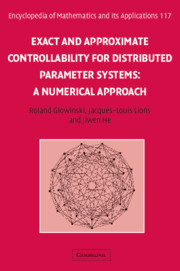Book contents
- Frontmatter
- Contents
- Preface
- Introduction
- Part I Diffusion Models
- 1 Distributed and point wise control for linear diffusion equations
- 2 Boundary control
- 3 Control of the Stokes system
- 4 Control of nonlinear diffusion systems
- 5 Dynamic programming for linear diffusion equations
- Part II Wave Models
- Part III Flow Control
- Epilogue
- Further Acknowledgements
- References
- Index of names
- Index of subjects
3 - Control of the Stokes system
from Part I - Diffusion Models
Published online by Cambridge University Press: 04 August 2010
- Frontmatter
- Contents
- Preface
- Introduction
- Part I Diffusion Models
- 1 Distributed and point wise control for linear diffusion equations
- 2 Boundary control
- 3 Control of the Stokes system
- 4 Control of nonlinear diffusion systems
- 5 Dynamic programming for linear diffusion equations
- Part II Wave Models
- Part III Flow Control
- Epilogue
- Further Acknowledgements
- References
- Index of names
- Index of subjects
Summary
Generalities. Synopsis
In the original text (that is, Acta Numerica 1995), the content of this chapter was considered as a preliminary step to a more ambitious goal, namely, the control of systems governed by the Navier–Stokes equations modeling incompressible viscous flow. Indeed, substantial progress concerning this objective took place in the late 1990s (some of them to be reported in Part III of this book), making – in some sense – this chapter obsolete. We decided to keep it since it addresses some important issues that will not be considered in Part III (and also because it reflects some of the J.L. Lions scientific concerns at the time).
Back to the original text, let us say that the control problems and methods which have been discussed so far in this book have been mostly concerned with systems governed by linear diffusion equations of the parabolic type, associated with second-order elliptic operators. Indeed, these methods have been applied in, for example, Berggren (1992) and Berggren, Glowinski, and J.L. Lions (1996b), to the solution of approximate boundary controllability problems for systems governed by strongly advection dominated linear advection–diffusion equations. These methods can also be applied to systems of linear advection–diffusion equations and to higher-order parabolic equations (or systems of such equations). Motivated by the solution of controllability problems for the Navier–Stokes equations modeling incompressible viscous flow, we will discuss now controllability issues for a system of partial differential equations which is not of the Cauchy–Kowalewska type, namely, the classical Stokes system.
Information
- Type
- Chapter
- Information
- Exact and Approximate Controllability for Distributed Parameter SystemsA Numerical Approach, pp. 231 - 242Publisher: Cambridge University PressPrint publication year: 2008
